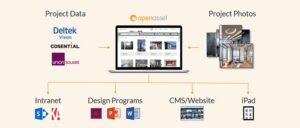Using DAM in Construction Bid Management
Dec 10, 2019

Bidding in construction management is an inescapable part of the construction sales process. However, winning new work has become somewhat perilous. Many companies are pricing projects at levels that can’t withstand the high risks often associated with construction.
In an audit report on the construction industry in the UK, the ICAEW (Institute of Chartered Accountants in England and Wales) concludes that to avoid creating an environment where procurement in the industry is unsustainable, construction firms need to undertake more responsible tendering practices during the bid process.
Delivering proposals that strike a balance between price and value sets the ground for a more stable relationship over time. And more honest proposals could help halt the side effects of the ‘race to the bottom’ experienced across the construction industry.
A bid submission allows you to deliver a pitch that highlights your firm’s strengths and deliver it to an audience you know is listening. Your bid will also show the client that you understand their needs for this project, and demonstrate that you are the right company to fulfill those needs.
How important is a value proposition?
Bid submissions in construction are a labor-intensive task and synonymous with short timeframes for response. It can feel like there isn’t the time for much more delivering the essentials, such as pricing.
Although your team can be stretched just to get a response back by the deadline, often it’s the bid that gets in the fastest that acts as a benchmark for the other quotes that arrive later.
If you know that you’ll be up against competitors looking to undercut the competition at any cost, offering a bid that focuses on why you’re the best partner for the project is an absolute must. If you’re the first bid in, your pricing is transparent, and you’re showing the client why your firm is superior to the competition, you will be the benchmark.
While clients don’t want to pay over the odds, they will be all too aware of the risks associated with an extremely low price. Most clients will be looking for additional value. If five bids contain almost identical pricing, the bid that adds value and addresses a project’s underlying needs will stand head and shoulders above the competition.
A good bid proposal will speak to the client; it will address their needs, key issues, values, and goals. To be successful, you need to be responsive to a client’s needs. But responsiveness means more than just being blindly compliant.
By presenting a full value proposition rather than merely offering the lowest pricing you can sustain, your firm has the opportunity to highlight:
- Why your proposition provides the best all-round value
- How your firm has the right experience to complete the project on time
- Assurance about the quality of your work.
- The risks of going with the cheapest quote
However, it is crucial to recognize that often the early stages of a bid, are not necessarily about finding a “winner”, rather identifying the “losers”. Losers are those companies that don’t understand the project needs or are unable to deliver a bid that meets their requirements.
Your proposal response should provide proof of the value you can offer, in the context of what is most important to the client.
Bid & proposal response teams
Getting a firm grip on a bid request means creating a team that’s ready to spring into action when needed. This team will ideally be a mix of expertise from within your business. Aside from the estimator, this team could include representatives from marketing, management, and commercial teams.
When a bid request lands, a swift team meeting to agree on strategy and timeframe for response is all that’s needed to kick off the project.
While the Construction Estimators are hard at work computing that all-important pricing, the rest of the team can be working in parallel to deliver an awe-inspiring value proposition to complement the pricing submission.
Create superior proposals with technology
In the past, the information needed for bid creation might be filed away in a cabinet, hidden in a large spreadsheet, or in the heads of a small number of key individuals. But in the digital age, cloud-based applications have created commercial efficiencies not previously possible.
Construction bidding software has become an essential part of many construction businesses. Bid management software makes it easy for estimators to create accurate bids and significantly reduce turnaround time.
Other cloud-based applications, such as CRM and ERP, give firms access to a wealth of relevant information. This information enables sales and marketing teams to produce revenue-generating commercial content. Digital Asset Management (DAM) is a SaaS platform fast becoming as essential for AEC firms as CPM, CRM, or ERP.
Digital Asset Management is a way of centrally managing digital assets and content. With a DAM system, digital assets are searchable and can be utilized in ways that management on native operating systems does not allow. When integrated with other systems in your tech stack, DAM can help to streamline the creation of value propositions in your bid.
A DAM can help the commercial workflow by giving users access to the content needed to create proposals, manage website content, social media, and much more. For example:
- High-Quality Marketing Photography
- Videos and drone footage
- InDesign files
- Word documents
- PDFs
- Company brand items
- Presentations
- Marketing content and collateral
OpenAsset is the only project-based DAM made, especially for firms working in the built environment. It manages content in the same way that you manage your business – based around projects, properties, places, and people. DAM can integrate with other systems in your tech stack, adding essential project and customer information to visual assets and files.
With OpenAsset you can:
- Connect OpenAsset to your ERP or CRM, and you can synchronize project data with the digital assets in your DAM.
- Create templates to push assets and data straight from OpenAsset into PowerPoint or InDesign and create new proposals at the touch of a button.
- View your projects on an interactive map that enables you to quickly find projects relevant to the projects you’re tendering for
- Create employee resumes directly from OpenAsset
- Create project portfolios that allow you to showcase your work to clients
DAM can be a powerful collaboration tool for more efficient working for the whole bid team. Research by OpenAsset confirms this notion. Our survey revealed that in AEC firms with a DAM, the time marketing teams spend working on RFP responses decreases.
Ultimately, using a DAM in combination with the other applications in your tech stack, you can improve the quality and speed of your proposals.





